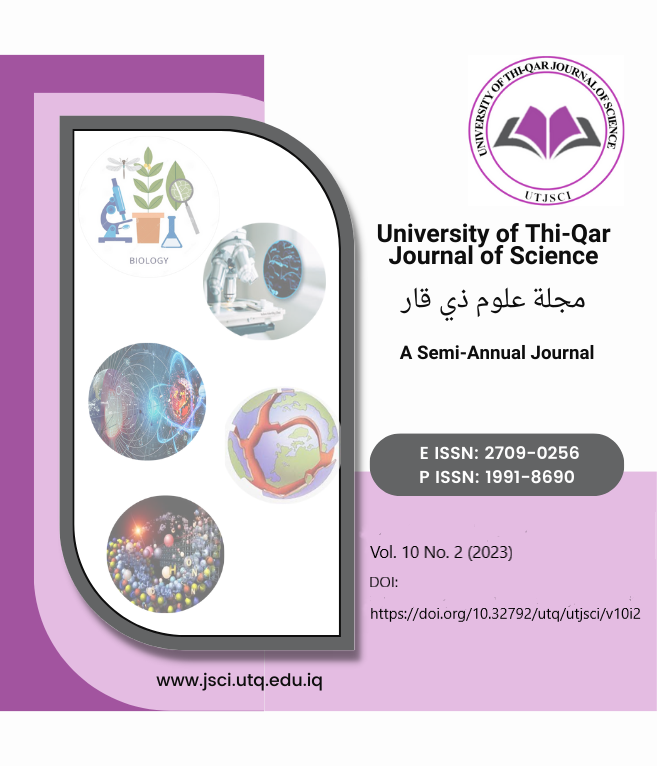High Efficiency (22.46) of Solar Cells Based on Perovskites
DOI:
https://doi.org/10.32792/utq/utjsci/v10i2.1140Keywords:
Perovskite, efficiency, SCAPS-1D, Density of State, Fill Factor (FFAbstract
In this research we have considered (CH₃NH₃PbX₃) (X=I,Cl,Br) as an absorber layer and Cu2O/spiro-OMeTAD/ P3hT/PEDOT:PSS as (HTM) along with PCBM/TiO₂ as (ETM). It is a solid-state planar heterojunction p-i-n solar cell with low p-type-doped, CH₃NH₃PbX₃ sandwiched between the p-type is called HTM layer and n-type. SCAPS-1D simulation software is used for numerical simulation to examine the influence of various electrical factors on the efficiency PCBM/CH₃NH₃PbCl3/P3hT,PCBM /CH₃NH₃PbI₃/P3hT,PCBM/MAPbCl₃/Cu2O,TiO2/MAPbCl₃/Sipro-OMeTAD, TiO₂/MAPbI3/Sipro-OMeTAD, PCBM /CH₃NH₃PbBr3/ PEDOT:PSS, and PCBM /CH₃NH₃PbI₃/ PEDOT:PSS heterojunction-based perovskite solar cell structures. With these variables an efficiency of 22.46% was obtained at 263.15(k). By using SCAPS simulation software
Received: 2023-12-04
Revised: 2023-12-21
Accepted: 2023-12-23
References
] S. Zheng, G. Wang, T. Liu, L. Lou, S. Xiao, S. Yang; 2019;Materials and structures for the electron transport layer of efficient and stable perovskite solar cells. Sci. China Chem. 62 (2019)800–809. https://doi.org/10.1007/s11426-. [Online]
X. Zeng et al., “Performance improvement of perovskite solar cells by employing a CdSe quantum dot/PCBM composite as an electron transport layer,” J. Mater. Chem. A, vol. 5, no. 33, pp. 17499–17505, 2017.
K. Mahmood, S. Sarwar, M.T. Mehran; 2017;Current status of electron transport layers in perovskite solar cells. : materials and properties, RSC Adv. 7(2017) 17044–17062. https://doi.org/10.1039/c7ra00002b. [Online]
Niemgeers,A., Burgelman, M., Decock, K., Verschraegen, J., & Degrave, S ,.SCAPS manual. University of Gent., (2014).
J. Tian et al., “Enhanced performance of CdS/CdSe quantum dot cosensitized solar cells via homogeneous distribution of quantum dots in TiO2 film,” J. Phys. Chem. C, vol. 116, no. 35, pp. 18655–18662, 2012.
S. Kirchmeyer and K. Reuter, “Scientific importance, properties and growing applications of poly (3, 4-ethylenedioxythiophene),” J. Mater. Chem., vol. 15, no. 21, pp. 2077–2088, 2005.
J. Kim and S. L. Chuang, “Theoretical and experimental study of optical gain, refractive index change, and linewidth enhancement factor of p-doped quantum-dot lasers,” IEEE J. Quantum Electron., vol. 42, no. 9, pp. 942–952, 2006.
S. Mou, J. V Li, and S. L. Chuang, “Quantum efficiency analysis of InAs–GaSb type-II superlattice photodiodes,” IEEE J. Quantum Electron., vol. 45, no. 6, pp. 737–743, 2009.
Farhana Anwar, Rafee Mahbub, Sakin Sarwar Satter, and Saeed Mahmud Ullah., “Effect of Different HTM Layers and Electrical Parameters on ZnO Nanorod-Based Lead-Free Perovskite Solar Cell for High-Efficiency Performance,”. Hindawi International Journal of Photoenergy,. 2017.
M. F. Hossain, M. Faisal, and H. Okada, "Device modeling and performance analysis of perovskite solar cells based on similarity with inorganic thin film solar cells structure," in 2016 2nd International Conference on Electrical, Computer & Telecommunication Engineering (ICECTE), 2016, pp. 1-4.
Noel et al. “Lead-Free Organic-Inorganic Tin Halide Perovskites for Photovoltaic Applications,”. Energy Environ. Sci., vol. 7, pp. 3061–3068, 2014.
Liu et al. “Numerical simulation: Toward the design of high-efficiency planar perovskite solar cells,” . Appl. Phys. Lett., vol. 253508, no. 104, 2014.
Hansong Xue et al .,“Correlating variability of modeling parameters with photovoltaic performance: Monte Carlo simulation of a meso-structured perovskite solar cell,”. Applied Energy,2019.
F. Behrouznejad, S. Shahbazi, N. Taghavinia, H.-P. Wu, andE. W.-G. Diau,. “A study on utilizing different metals as the back contact of CH3NH3PbI3 perovskite solar cells,” . Journal of Materials Chemistry A, vol. 4, pp. 13488–13498, 2016.
P. Qin, S. Tanaka, S. Ito et al., “Inorganic hole conductor-based lead halide perovskite solar cells with 12.4% conversion efficiency” . Nature Communications, vol. 5, no. 3834, 2014.
Downloads
Published
License
Copyright (c) 2023 University of Thi-Qar Journal of Science

This work is licensed under a Creative Commons Attribution 4.0 International License.













